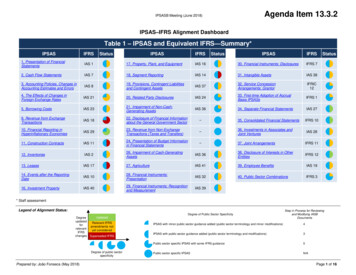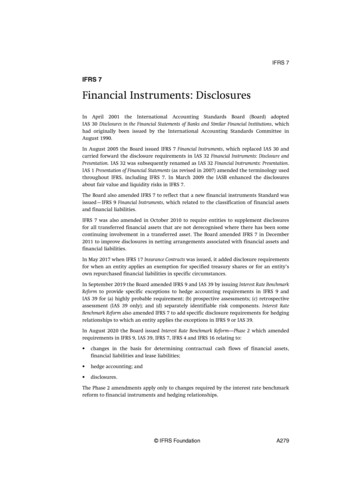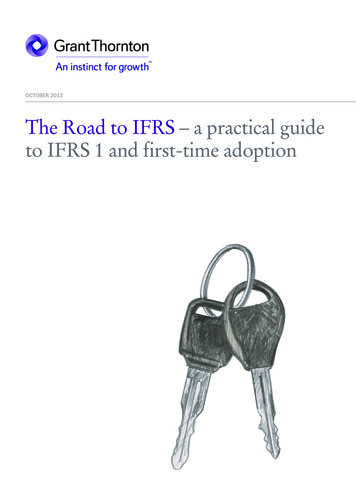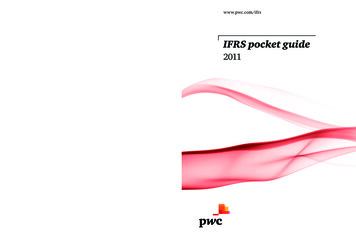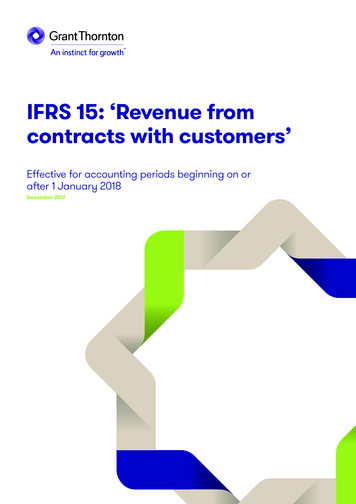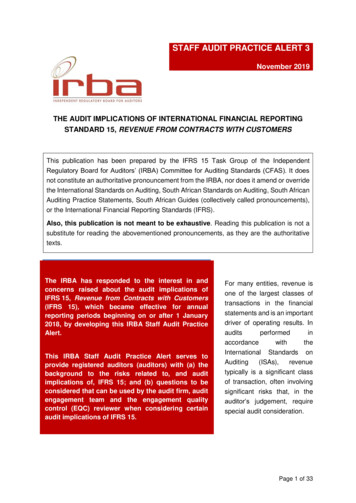
Transcription
IFRS 9 expectedExpectedCredit losscreditLossMaking sense of thechange in numberstransitionimpact
ContentsExecutive summary1Main features of the IFRS 9 ECL model2Availability and granularity ofECL disclosures3Overall ECL transition impact4ECL transition impact forcredit-impaired loans6ECL transition impact for the ‘good’ book8Regulatory impact10Towards enhanced transparency12
IFRS 9 expected credit loss:making sense of the transition impactFor banks reporting under International Financial ReportingStandards (IFRS), 1 January 2018 marked the transition tothe IFRS 91 expected credit loss (ECL) model, a new era forimpairment allowances.The road to implementation has been long and challenges remain.EY supported banks throughout the implementation journeywith a series of annual surveys that provided ‘state of readiness’benchmarks and implementation trends2.This publication complements the series of surveys with aquantitative analysis of the transition to ECL in terms of impact onthe financial statements3 and Core Equity Tier 1 ratio (CET1 ratio).Beyond the change in numbers, it discusses the main factors thatexplain differences between banks and countries.The analysis was conducted on a sample of large banksrepresenting continental Europe, the UK and Canada. Althoughpresented on an anonymous basis, it is entirely based on publiclyavailable information, such as 2017 annual reports, IFRS 9transition reports and Q1 2018 quarterly reports.Figure 1: Sample of banks, by countryCanada (CA)France (FR)Germany (DE)Italy (IT)Netherlands (NL)Spain (SP)Switzerland (CH)United Kingdom (UK)012345Number of banksExecutive summaryThe transition to IFRS 9 generally resulted in an increase inimpairment allowances. The impacts on financial statementsand CET1 ratio are, in most cases, lower than previouslyestimated, reflecting in part more favourable economicconditions.With a few exceptions, allowances for credit-impaired loansremained fairly stable compared with IAS 39, which alreadyrequired estimation of lifetime expected losses for theseexposures. For non-impaired loans, ECL allowances aregenerally higher than IAS 39 collective allowances. Significantdifferences in transition impacts appear between banks,including at the country level. Many of the factors that explainthese differences are typical drivers of changes in impairment,such as the bank size, its portfolio mix and geographicalfootprint. Transition impacts also reflect differentjudgements and estimates in terms of ECL methodologicalchoices and forward-looking scenarios. In addition, severalfactors not related to the ECL approach had a significantimpact on transition, such as reclassifications, write-offpolicies, and the treatment of purchased and originatedcredit-impaired (POCI) loans.These drivers and their complex interactions illustratesome of the challenges ahead for banks in explainingchanges in allowances and for financial statements users inunderstanding them.IFRS 9 Financial InstrumentsEY IFRS 9 Impairment Banking surveys 2015-2018.3 This analysis is focused on ECL allowances for loans. Exposures resulting from cash in bank accounts, securities, guarantees and credit commitments were excludedwhenever they were disclosed separately.12IFRS 9 expected credit loss Making sense of the transition impact1
Main features of the ECL modelUnder IAS 39, impairment allowances were measured accordingto an ‘incurred’ loss model wherein the recognition of credit lossallowances was triggered by loss events subsequent to origination.Losses ‘incurred but not reported’ were evaluated using diverseprovisioning approaches, varying between banks and countries.The new IFRS 9 impairment model requires impairment allowancesfor all exposures from the time a loan is originated, based on thedeterioration of credit risk since initial recognition. If the creditrisk has not increased significantly (Stage 1), IFRS 9 requiresallowances based on 12 month expected losses. If the credit riskhas increased significantly (Stage 2) and if the loan is ‘creditimpaired’ (Stage 3), the standard requires allowances based onlifetime expected losses.The assessment of whether a loan has experienced a significantincrease in credit risk varies by product and risk segment. Itrequires use of quantitative criteria and experienced credit riskjudgement.As opposed to IAS 39 which required a best estimate approach,IFRS 9 requires multiple forward-looking macro-economic andworkout scenarios for the estimation of expected credit losses.4US GAAP perspectiveThe US Financial Accounting Standards Board (FASB)published a new impairment standard4 based on ‘currentexpected credit losses’ (CECL) in 2016, which significantlychanges accounting for credit losses for most financial assetsand certain other instruments that are not measured atfair value through net income. The earliest effective date isthe beginning of 2020 for calendar-year entities that meetthe definition of a public business entity. Early adoption ispermitted for all entities beginning in 2019.Similar to IFRS 9, the FASB’s model is forward-looking,no longer requires a ‘trigger event’ for the recognition ofimpairment allowances and should be based on reasonableand supportable information.The two standards differ the most in terms of the period overwhich losses are measured and recognised. The FASB’s modelrequires measurement of lifetime ECL from the time of loanorigination. Compared to IFRS 9 ‘staged’ approach, this leadsto a higher expected impact on transition to CECL.Accounting Standards Update 2016-13, Financial Instruments — Credit Losses (Topic 326), Measurement of Credit Losses on Financial Instruments.2IFRS 9 expected credit loss Making sense of the transition impact
Availability and granularity of ECL disclosuresWhile several sources of information currently provide insights on the IFRS 9 impact on loan provisions, their granularity and level ofdetail vary, in some instances due to country-specific requirements.Figure 2: Sources of ECL informationYE 2017annual reportsA majority of bankspublished IAS 8 disclosures: High-level estimates ofthe IFRS 9 impact on thefinancial statements Impact on CET1 ratioTransitionreportsQ1 2018 IFRSquarterly reportsYE 2017 and Q12018 financialcommunicationUK banks and two otherEuropean banks publishedIFRS transition reports:Canadian, German and Swissbanks published Q1 IFRSfinancial reports:Some banks provided moredetailed information than inYE 2017 annual reports: Detailed transitiondisclosures Detailed transitiondisclosures Updates of YE 2017impact estimates ‘Business-as-usual’disclosures on balancesheet, exposures, riskestimates Some ‘business-as-usual’disclosures Detailed transitioninformation in Q1 2018The first ECL disclosures provided in year-end (YE) 2017 annualreports were high-level estimates of the increase in loan allowancesand impact on CET1 ratio. In the UK, shortly after the yearend,banks published IFRS 9 ‘transition reports’, a comprehensive setof accounting and regulatory disclosures. These reports explainthe impact of IFRS 9 on classification, measurement and loanallowances, and include ‘deep dives’ on exposures and provisionsby stage, business line and product. Besides UK banks, two otherEuropean banks published transition reports on a voluntary basis.IFRS 9 expected credit loss Making sense of the transition impactSome banks in the sample, such as Canadian, German and Swissbanks have published Q1 IFRS accounts, which include full IFRS 9transition disclosures and most ‘business-as-usual’ disclosures,including breakdowns of exposures and ECL allowances per stage,as well as changes in ECL allowances over the quarter.At the time of writing, some banks in the sample had solely providedrevised impact estimates and limited transition information in theirQ1 financial communication and as a result, are not included insome of the figures presented in this analysis.3
Overall ECL transition impactThis transition impact analysis is focussed on some of the keyindicators that we expect financial statement stakeholders will useto compare banks under IFRS 9, such as the level of provisions,coverage ratios and equity impact upon transition. Portfolio mix: Generally, retail portfolios experienced largerincreases in loan provisions. For credit cards in particular,the impact is significant for some banks, as a consequence oflonger expected lives for deteriorated exposures varying fromtwo to nine years.Coverage ratios Stage 3 loans (impaired loans): For some banks, the useof multiple workout scenarios for impaired loans is anothernoteworthy factor driving the increase in provisionsEquityimpactWrite-offsFor the majority of banks analysed, the transition to IFRS 9generally results in an increase in allowances, ranging from a fewmillions to EUR4 billion (Figure 3).Figure 3: Increase in loan allowances, by amount Significant judgments and estimates: It is well knownthat IFRS 9 ECL guidance leaves room for judgement onkey concepts such as whether there has been a significantincrease in credit risk, measurement of lifetime expected creditlosses and forward-looking assumptions. Differences in keyjudgements and estimates between banks undeniably explainsome of the differences observed. More detailed disclosuresand sensitivity analyses would be helpful to financialstatements users in these areas. IAS 39 provisioning practices: How banks applied IAS 39 isalso a key driver for of the change in allowances reflected bythe impact on the ‘good’ book (i.e., on provisions for Stage 1and Stage 2 loans under IFRS 9).(IT) Bank 2(FR) Bank 1(UK) Bank 3(FR) Bank 4Financial statement disclosures reflect several significantfactors not directly linked to the expected loss measurementapproach that partially offset the expected increase in allowanceson transition:(UK) Bank 1(UK) Bank 5(FR) Bank 2(FR) Bank 3 Reclassifications: Decreases in the impairment allowance ontransition are in some cases explained by reclassifications ofloans from amortised cost to fair value through profit or loss(FVTPL), for which there is no allowance.(SP) Bank 1(UK) Bank 2(DE) Bank 1(NL) Bank 1 Write-off policies: For some banks, changes in write-offpolicies implemented simultaneously with IFRS 9 reducedthe overall increase in allowances upon transition. Someimpaired loans were fully or partially derecognised, resultingin a decrease in gross loans balances and related impairmentallowances.(CA) Bank 2(IT) Bank 1(CH) Bank 1(NL) Bank 2(CA) Bank 1(CA) Bank 3(DE) Bank 2-1012EUR billions4Bank size is a significant contributor to the magnitude of theincrease in loan allowances (Figure 4). However, there are notableexceptions. Some point to the multitude of factors that typicallytrigger changes in loan provisions, such as the bank’s product mixand its geographical footprint. Others include regional trends inIAS 39 provisioning practices and differences in the significantjudgements involved in the ECL methodology.34 Purchased and originated credit impaired (POCI) loans: Forsome banks, loans deemed POCI on transition also led to adecrease in the impairment allowance, expected credit lossesbeing included in the carrying amount for these assets.IFRS 9 expected credit loss Making sense of the transition impact
These factors and their interactions illustrate some ofthe challenges banks faced in providing comparable andcomprehensive IFRS 9 transition disclosures, while distinguishingbetween the impact of the ECL approach and related judgementsand those resulting from reclassifications, changes in write-offpolicies and POCI.Figure 4: Increase in loan allowances, by bank size(UK) Bank 1(FR) Bank 1(FR) Bank 3(DE) Bank 1These changes need to evaluated to comprehend the impactof the ECL transition on total coverage ratios, which we furtherdiscuss below.(UK) Bank 3(FR) Bank 2(FR) Bank 4From 2016 to 2017, total coverage ratios under IAS 39decreased, likely reflecting improving macro-economic conditions,followed by an increase on transition to IFRS 9 (Figure 5).The impact on total coverage ratios ranges from -5 bps toapproximately 40 bps, with a couple of exceptions, notablyfor UK Bank 3 (a 100 bps increase, mainly due to increasedimpairment allowances on credit cards), Italian Bank 2 (a 70 bpsincrease, due to the incorporation of sale strategies in Stage 3impairment allowances).(UK) Bank 5(CA) Bank 3(NL) Bank 1(IT) Bank 1(UK) Bank 2(CA) Bank 2(IT) Bank 2(CH) Bank 1(SP) Bank 1(CA) Bank 1(DE) Bank 2(NL) Bank 2-1012EUR billions34Changes in write-off policies leading to earlier write-offs explainwhy some banks (such as Italian Bank 1) did not experience ahigher increase in coverage ratios. These changes are furtherexplained in the section related to credit-impaired loans.Figure 5: Total coverage ratios57%6%5%4%3%2%1%0%(CA) Bank 1 (CA) Bank 2 (CA) Bank 3CA(CH) Bank 1CH(DE) Bank 1(DE) Bank 2DETotal IFRS 9 coverage ratio5(FR) Bank 2(FR) Bank 3(FR) Bank 4(IT) Bank 1FRTotal IAS 39 coverage ratio YE 2017(IT) Bank 2IT(SP) Bank 1(UK) Bank 1SP(UK) Bank 2(UK) Bank 3UKTotal coverage ratio YE 2016 otal overage ratio: the numerators are respectively the IAS 39 total loan loss allowance and the IFRS 9 total ECL allowance, and the denominators are gross loan balancesTexcluding cash, securities and off-balance sheet exposures.IFRS 9 expected credit loss Making sense of the transition impact5
ECL transition impact for credit-impaired loansThe majority of banks have aligned the accounting definitionsof default and credit-impaired loans with the regulatorydefinition of default. With a few exceptions, allowances forcredit-impaired exposures remained fairly stable compared to IAS39 which already required estimation of lifetime expected lossesfor these loans.Based on UK banks IFRS 9 transition reports, an upward trendis noted for collateralised portfolios, due to the incorporationof multiple forward-looking scenarios upon transition toIFRS 9. Decreases in allowances are in some instances due to thereclassification of impaired loans to fair value through profit or loss(e.g., German Bank 2).Figure 6: ECL allowances for credit-impaired loans3025EUR billions20151050(CA) Bank 1(CA) Bank 2CA(CA) Bank 3(CH) Bank 1CH(DE) Bank 1(DE) Bank 2(FR) Bank 2DEIFRS 9 Stage 3 ECL allowancesRecovery estimates: The IFRS Transition Group for Impairmentof Financial Instruments (ITG) confirmed in September 2015 thatthe cash flows expected from the sale of loans in default shouldbe included in the measurement of expected credit losses. Forbanks with significant sale plans for non-performing assets, theexpected discount in sale prices resulted in a significant decrease6(FR) Bank 3FR(FR) Bank 4(IT) Bank 1(IT) Bank 2IT(SP) Bank 1SP(UK) Bank 1(UK) Bank 2(UK) Bank 5UKIAS 39 impaired loans allowancesin recovery estimates. The incorporation of sale strategies inprovisioning methodologies triggered significant increases inprovisions for credit-impaired loans for these banks, such as forex-ample for Italian Banks 1 and 2. For Italian Bank 1, we notethat the impact of recovery estimates was offset by simultaneouswrite-offs.The definitions of ‘credit-impaired’ and “non-performing” loans are not identical.6IFRS 9 expected credit loss Making sense of the transition impact
Write-off policies: Changes in write-off policies upon transitionled some banks to derecognise all or parts of lower-quality,higher coverage ratios loans. This reduced credit-impairedloan balances and their coverage ratios. Major differences inwrite-off policies between countries and banks significantly reducethe comparability of these exposures. In general, French and Italianbanks write-off credit-impaired loans later than UK and Canadianbanks, based on local recovery law considerations. New trendsmay emerge as a consequence of the ECB’s focus on reducingnon-performing6 loans, often reported based on gross balances.classified as ‘impaired’ under IAS 39, which generally addedbetter-quality, lower-coverage assets to credit-impaired exposures.These increases in the population of credit-impaired loansdiluted their coverage ratios. For example, UK Bank 2 states thatcreditimpaired assets now include assets that have defaulted butfor which they expect full recovery.The impacts on impaired loans coverage ratios (Figure 7)reflect these differences in the definition ‘credit-impaired’loans and write-off policies. They vary from bank to bank,from decreases for some banks (e.g., German Bank 1 andUK Bank 2) to low or moderate increases for the majority ofbanks, and significant increases for two banks (UK Bank 1 andCanadian Bank 2).Scope/definition of credit-impaired loans: A number of bankshave changed the scope of credit-impaired loans on transition.These banks classified loans as Stage 3 earlier than they wereFigure 7: Coverage ratios7 for credit-impaired loans70%60%50%40%30%20%10%0%(CA) Bank 1(CA) Bank 2CA(CA) Bank 3(CH) Bank 1CH(DE) Bank 1(FR) Bank 2(FR) Bank 3DECoverage ratio IFRS 9 Stage 3 loansFR(FR) Bank 4(IT) Bank 1(IT) Bank 2IT(SP) Bank 1(UK) Bank 1SP(UK) Bank 2(UK) Bank 5UKCoverage ratio IAS 39 impaired loans YE 2017Coverage ratios computation: the numerators are respectively the IAS 39 allowance for credit-impaired loans and the IFRS 9 Stage 3 ECL allowance, and the denominatorsare respectively the balances of credit-impaired loans under IAS 39 and IFRS 9.7 IFRS 9 expected credit loss Making sense of the transition impact7
ECL transition impact for the ‘good’ bookFor non-impaired loans (Stage 1 and Stage 2 under IFRS 9, or the‘good’ book), ECL allowances appear consistently higher than theIAS 39 allowances for non-impaired loans, with the exception ofthose of Canadian banks (Figure 8).For these exposures, differences in IAS 39 practices anddifferences related to product mix affected the transition impact,as further discussed below.Figure 8: IFRS 9 Stage 1 and Stage 2 allowances versus IAS 39 allowances for non-impaired loans6EUR billions543210(CA) Bank 1 (CA) Bank 2 (CA) Bank 3CA(DE) Bank 1 (DE) Bank 2CH(FR) Bank 2 (FR) Bank 3 (FR) Bank 4DEIFRS 9 Stage 1 and Stage 2 ECL allowances IAS 39 provisioning practices: The level of IAS 39nonimpaired loans allowances varied significantly frombank to bank due to either country-related, or bank-specificprovisioning practices. ‘Incurred-But-Not-Reported’ (IBNR) approach versuscollective allowances for ‘deteriorated exposures’: Theanalysis of IAS 39 provisioning practices shows that bankswhich calculated ‘incurred but not reported’ allowances using8FR(IT) Bank 1(IT) Bank 2IT(SP) Bank 1SP(UK) Bank 1 (UK) Bank 2 (UK) Bank 5UKIAS 39 collective provisionsemergence periods (e.g., Canadian and UK banks) generallyexperienced a higher increase for Stage 2 allowances, while theimpact on Stage 1 was limited to the difference between theIAS 39 emergence period and the minimum 12M ECL horizonrequired under IFRS 9. On the contrary, banks which had IAS39 collective allowances based on deteriorated exposures (e.g.,French banks) set up ECL allowances for Stage 1 exposuresupon transition and generally experienced a smaller impact ontheir Stage 2 allowances.IFRS 9 expected credit loss Making sense of the transition impact
Product mix: The product mix plays a significant role in theincrease in allowances for non-impaired exposures (‘good’book), with the following trends observed at product level:enhancement mechanisms result in lower LGDs as well as arelatively low sensitivity to macroeconomic parameters. Limited impact on wholesale portfolios, for which watchlist and sector provisions, or IBNR provisions resultedin relatively high coverage under IAS 39 (e.g., Franceand Canada). Some banks noted little change, or even adecrease, primarily resulting from the use of relatively longemergence periods under IAS 39. Significant impact on credit cards and unsecured personallending, which have higher probability of default (PDs)and loss given default (LGDs). The inclusion of undrawnamounts and behavioural lifetimes for Stage 2 allowanceswere major drivers of the increase in allowance upontransition, particularly in the UK and Canada where theseproducts generally represent a larger share of banks’ totalexposures. Some impact on mortgage loans for which IAS 39non-impaired loans allowances were based on shorteremergence periods, or triggers generally delayedcompared to the IFRS 9 Stage 2 triggers. However, thetransition impact for mortgage portfolios was low tomoderate for the majority of banks, due to lower LGDsand positive real estate trends at the time of transition.Also, in countries such as France or Canada8, local credit The overall impact on banks with large internationalportfolios also reflects country-specific productconsiderations.Similar to credit-impaired portfolios, the comparison betweenbanks can be slightly distorted by differences in the definition ofcredit-impaired between banks: the narrower the definition, thebigger the ‘good’ book allowance, and vice versa.Overall, the factors discussed above indicate that the analysis ofthe amount and/or percentage increase upon transition should besupplemented by a review of qualitative disclosures .Figure 9: Coverage ratios for non-impaired loans1.2%1.0%EUR billions0.8%0.6%0.4%0.2%0(CA) Bank 1 (CA) Bank 2CA(CA) Bank 3(CH) Bank 1CH(DE) Bank 1(FR) Bank 2 (FR) Bank 3DECoverage ratio IFRS 9 non-Impaired loans8(FR) Bank 4FR(IT) Bank 1(IT) Bank 2IT(SP) Bank 1 (UK) Bank 1 (UK) Bank 2 (UK) Bank 5SPUKCoverage ratio IAS 39 non-Impaired loans YE 2017Canada Mortgage Housing Corporation (CMHC) programs in Canada and ‘Crédit Logement’ in FranceIFRS 9 expected credit loss Making sense of the transition impact9
Regulatory impactThe impact on the regulatory CET1 ratio was a key indicator usedby banks to quantify the IFRS 9 transition impact in their financialcommunications.There are significant differences between the impact on CET1ratios (Figure 10) and changes in impairment allowances(Figure 3). Note that banks are shown in the same order as inFigure 3 (i.e., from the highest to the lowest change in provision).Figure 10: Impact on CET1 ratioshareholders’ equity on transition when they lead to changes inmeasurement from amortised cost to fair value and vice versa. Insome cases, the positive effects of reclassifications substantiallyoffset the increase in impairment allowances (for example, for UKBanks 1 and 2). In other instances (for example, German Bank 2),they have a negative effect.Second, the increase in allowances results in deferred tax assets,which lowered the overall impact on IFRS Shareholders Equity andCET1 ratio. Deferred tax assets are subject to a cap, which led to a‘haircut’ in the regulatory capital impact for some banks.For exposures under internal rating based (IRB) approaches,the most important driver of the difference between theaccounting impact and regulatory impact is the ‘shortfall’ ofaccounting allowances compared with regulatory expected losses,which is deducted from CET19. The amount of the shortfall variedfrom bank to bank, depending on their provisioning practices andthe extent of IRB exposures as a percentage of total exposures.This resulted in different levels of absorption of the IFRS 9increase in allowances.(IT) Bank 2(FR) Bank 1(UK) Bank 3(FR) Bank 4(UK) Bank 1(UK) Bank 5(FR) Bank 2(FR) Bank 3(SP) Bank 1 This leads to somewhat counter-intuitive results, such as a highimpact on CET1 ratios for banks with high coverage ratios. Forexample, French Bank 3 experienced a high impact on its CET1ratio due to a limited amount of shortfall available to absorbthe increase, compared to other banks which experienced asimilar level of increase in allowances.(UK) Bank 2(DE) Bank 1(NL) Bank 1(CA) Bank 2(IT) Bank 1(CH) Bank 1(NL) Bank 2(CA) Bank 1(CA) Bank 3(DE) Bank 2-100-80-60-40-20020In bpsWhat is driving the differences?First, the impact on CET1 ratio reflects reclassificationsof loans which occurred upon implementation of the newIFRS 9 classification model. Such reclassifications affect IFRS Italian banks had limited or no shortfall to absorb theincrease in allowances, partly because their coverage ratiosunder IAS 39 were already high and partly due to the useof the IRB approach for a relatively lower portion of theirexposures. On on average, 50% of their exposures are underIRB approaches, compared to more than 70% for other banksincluded in the sample.For exposures under the standardised approach, the increasein allowance decreased risk weighted assets. This also reducedthe transition impact on CET1 ratios, although to a lower extentthan for IRB exposures. For further details, please refer to ourpublication ‘Regulatory impact of accounting provisions’.Refer to EY Regulatory Impact of Accounting Provisions for further details.9 10IFRS 9 expected credit loss Making sense of the transition impact
Finally, European banks have the ability to apply transitionalarrangements and spread the impact of IFRS 9 impairmentrequirements over a 5-year period, with an impact of only5% in year 1. As reflected Figure 11, the application of thesetransitional measures varies by country. UK banks and mostSpanish and Italian banks elected to apply these measures.French, German and Dutch banks opted for an immediate impacton regulatory capital of ECL transition effects. Some bankswhich elected to apply the transitional measures experiencedan increase in CET1 as a result of reclassifications with positiveeffects on shareholders’ equity.Figure 11: Transition arrangements, country trendsYesNoFigure 12: Increase in allowances versus regulatory shortfall versus ECL impact on CET1 ratio1055555535435415EUR tsPoints(bps)(bps)153-451-65-650-850-85Increase in credit loss allowanceIn EUR billionsIncrease in credit loss allowanceIn EUR billions10Shortfall YE 2017In EUR billionsShortfall YE 2017In EUR billionsUK(UK) (UK)BankBank5 5(UK) (UK)BankBank3 3(UK) (UK)BankBank2 2SP(UK) (UK)BankBank1 1NL(SP) (SP)BankBank1 1IT(NL) (NL)BankBank1 1(IT) Bank(IT) Bank2 2(IT) Bank(IT) Bank1 1FR(FR) (FR)BankBank4 4(FR) (FR)BankBank3 3(FR) (FR)BankBank2 2DE(FR) (FR)BankBank1 1(DE) (DE)BankBank2 2CH(DE) (DE)BankBank1 1(CH) (CH)BankBank1 1CA(CA) (CA)BankBank3 3-105(CA) (CA)BankBank2 2-105-1(CA) (CA)BankBank1 1-1Impact on CET1 ratioIn bpsImpact on CET1 ratioIn bpsThe impact on CET1 ratio was considered on a « fully loaded » basis — i.e., excluding transitional arrangements relief.IFRS 9 expected credit loss Making sense of the transition impact11
Towards enhanced transparencyThe disclosures that became available in the transition reports andsome interim accounts reveal a fundamental change in the contentand granularity of credit provisioning information. Detailed tablesof exposures and ECL allowances by stage, business or productlines and credit quality, as well as coverage ratios by stage allowmore detailed quantitative comparisons.Figure 13: UK banks wholesale loans YE 2017Loans per stage — breakdown for wholesale loansHow users will analyse ECL disclosures remains to be seen. Ascomparing IFRS 9 methodologies is so complex, benchmarkingthe outputs becomes more important. New key ratios will likelyemerge as additional analysis becomes available on how the ECLimpairment model behaves.Figure 14: UK banks wholesale loans YE 2017ECL per stage and Stage 3 coverage ratio60%40%20%8%60%6%40%4%20%2%0%(UK) Bank 1(UK) Bank 2 (UK) Bank 3 (UK) Bank 4Stage 1Stage 2(UK) Bank 5Stage 3The ECL provisioning model is a major change in how banksapproach credit risk allowances. Beyond the impact of IFRS 9transition, we expect stakeholder scrutiny on whether the newmodel better prepares banks to face economic downturns andpromotes sound lending behaviour. The interaction betweenimpairment allowances and the bank’s risk appetite and pricingpractices will continue to be key areas of focus for investors,standard setters and regulators.In the short run, financial statement users will evaluate whetherthe ECL model and disclosures meet IASB’s objective of providingrelevant, understandable and comparable information about theamount, timing and uncertainty of future cash flows. This analysishighlights a number of areas that could benefit from enhanced1280%(UK) Bank 1 (UK) Bank 2Stage 1Stage 2(UK) Bank 3Stage 3(UK) Bank 4(UK) Bank 5Coverage ratio80%0%10%100%% of ECL in each stage% Loans in each stage100%0%Coverage Stage 3disclosures, with the most noteworthy being the definition ofcredit-impaired assets, write-off policies, and the sensitivity of ECLallowances to management judgement and estimates. We expectbanks will continue to enhance the transparency of ECL disclosuresin these areas and educate internal and external stakeholders onthe drivers of changes in ECL in the near future.We hope you find this information helpful as you continue yourIFRS 9 implementation journey.For questions and further information on how we can assist, pleaserefer to capabilities-assurance.IFRS 9 expected credit loss Making sense of the transition impact
AuthorsContributorsLaure GuéganAnthony CliffordEmail: laure.guegan@fr.ey.comTel: 33 1 46 93 63 58Email: aclifford@uk.ey.comMobile: 44 7767 706 499Monica RebreanuTara KenglaEmail: monica.rebreanu@fr.ey.comTel: 33 1 46 93 41 61Email: tkengla@uk.ey.comMobile: 44 7768 630 062IFRS 9 expected credit loss Making sense of the transition impact13
How EY can helpOur Financial Services (FS) are an integrated area thatincludes many professionals and IFRS 9 experts across manycountries (UK, Germany, France, India and many more), andcollaborates across competencies (Advisory, Assurance, Tax,Transaction Advisory): EY has been engaged by many global banks foraccounting change projects on a group-wide basis.We thus understand the complexities, challenges andopportunities of implementing IFRS across multiplegeographies, business units and diverse portfolios. Thus, we are one of the market-le
IFRS 9 expected credit loss Making sense of the transition impact 3 Figure 2: Sources of ECL information While several sources of information currently provide insights on the IFRS 9 impact on loan provisions, their granularity and level of

